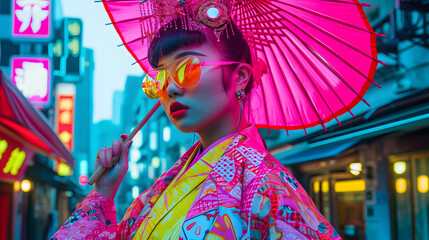Japanese fashion for women offers a fascinating blend of tradition and modernity, reflecting both cultural heritage and contemporary style. From the iconic kimono to the latest streetwear trends, Japanese fashion provides a rich tapestry of styles that continue to influence global fashion. This article delves into various aspects of women’s Japanese fashion, exploring its evolution, key elements, and current trends.
The Timeless Elegance of the Kimono
The kimono is perhaps the most recognizable element of traditional Japanese fashion. This elegant garment, characterized by its wrap-around design and intricate patterns, has been a symbol of Japanese culture for centuries. Made from luxurious fabrics such as silk, the kimono is often adorned with detailed embroidery and vibrant colors that reflect seasonal themes. Traditionally worn during special occasions such as weddings, festivals, and ceremonies, the kimono represents a deep connection to Japanese heritage. Modern adaptations of the kimono have emerged, incorporating contemporary fabrics and designs, making it accessible for everyday wear while still honoring its historical significance.
The Rise of Modern Japanese Streetwear
Japanese streetwear has gained international acclaim for its unique approach to casual fashion. Tokyo’s fashion districts, such as Harajuku and Shibuya, are renowned for their vibrant street style, blending eclectic influences with cutting-edge trends. Modern Japanese streetwear often features oversized silhouettes, bold graphics, and a mix of high and low fashion elements. Brands like A Bathing Ape (BAPE) and Comme des Garçons have become synonymous with this trend, offering innovative designs that push the boundaries of traditional fashion. Streetwear in Japan is not just about clothing but also about self-expression, with individuals curating their personal style to stand out in the bustling urban landscape.
The Influence of Minimalism in Japanese Fashion
Minimalism is a significant trend in Japanese fashion, emphasizing simplicity and functionality. This style is characterized by clean lines, neutral colors, and an emphasis on quality over quantity. Designers such as Issey Miyake and Rei Kawakubo have championed minimalism, creating collections that focus on innovative use of materials and thoughtful design. The minimalist approach is reflected in everyday wear, where versatile pieces can be mixed and matched to create a refined, understated look. This aesthetic values the beauty of simplicity, allowing each piece to stand out without overwhelming the wearer.
The Impact of Traditional Patterns and Textiles
Traditional Japanese patterns and textiles continue to play a crucial role in modern fashion. Patterns like cherry blossoms, waves, and cranes are often incorporated into contemporary designs, providing a connection to Japan’s cultural heritage. Fabrics such as indigo-dyed denim and brocade are used to add texture and depth to garments. Designers often reinterpret these traditional elements, blending them with modern silhouettes to create unique, culturally rich pieces. This fusion of old and new allows for a celebration of Japanese artistry while keeping fashion fresh and relevant.
The Role of Gender Fluidity in Contemporary Japanese Fashion
Contemporary Japanese fashion increasingly embraces gender fluidity, challenging traditional gender norms and creating inclusive designs. Designers like Yohji Yamamoto and Kenzo Takada have been at the forefront of this movement, offering collections that blur the lines between masculine and feminine aesthetics. Gender-neutral clothing often features oversized cuts, androgynous silhouettes, and a focus on comfort and functionality. This trend reflects a broader cultural shift towards acceptance and diversity, allowing individuals to express their identity through fashion without conforming to conventional gender expectations.
The Intersection of High Fashion and Street Style
The intersection of high fashion and street style in Japan creates a dynamic and influential fashion scene. High-fashion designers collaborate with streetwear brands to produce limited-edition collections that bridge the gap between luxury and casual wear. This blend of high and low fashion is evident in collaborations between brands like Louis Vuitton and Supreme, which combine the prestige of haute couture with the rebellious spirit of street fashion. This cross-pollination of styles results in innovative and exciting fashion that resonates with a diverse audience.
Also Red: 110 Best Ideas for Men Scarf Fashion in 2024
The Evolution of Japanese Fashion Icons
Japanese fashion icons have played a significant role in shaping the global fashion landscape. Figures such as Rei Kawakubo, the founder of Comme des Garçons, and Hanae Mori, known for her intricate designs, have made substantial contributions to the industry. Their work has influenced both Japanese and international fashion, pushing boundaries and redefining beauty standards. Contemporary icons like Rinko Kikuchi and Kiko Mizuhara continue to impact fashion with their unique personal styles and global presence, showcasing the versatility and innovation inherent in Japanese fashion.
The Influence of Pop Culture on Japanese Fashion
Japanese pop culture, including anime, manga, and J-pop, significantly impacts fashion trends. The vibrant, imaginative world of anime often inspires bold and whimsical fashion choices, while J-pop idols set trends with their ever-evolving styles. This influence is reflected in the playful and experimental aspects of Japanese fashion, where bright colors, cartoon motifs, and quirky accessories are common. Pop culture icons help drive fashion trends, creating a fusion of entertainment and style that captivates both domestic and international audiences.
The Future of Japanese Fashion: Innovation and Tradition
The future of Japanese fashion lies in its ability to balance innovation with tradition. Designers continue to explore new materials, technologies, and techniques while respecting the rich cultural heritage of Japan. Sustainability is becoming increasingly important, with a focus on eco-friendly practices and ethical production. The evolution of Japanese fashion will likely see a continued blending of traditional aesthetics with modern advancements, resulting in a fashion landscape that is both forward-thinking and deeply rooted in cultural history.
Conclusion
Women’s Japanese fashion is a vibrant and evolving field that showcases a rich tapestry of traditional and contemporary styles. From the timeless elegance of the kimono to the cutting-edge trends of modern streetwear, Japanese fashion offers a diverse array of influences and innovations. By embracing both historical significance and future possibilities, Japanese fashion continues to captivate and inspire, reflecting the dynamic spirit of a culture that values both tradition and creativity.
FAQs
1. What is women’s Japanese fashion?
Women’s Japanese fashion encompasses a range of styles and trends originating from Japan. It includes both traditional garments, like the kimono, and modern streetwear influenced by Japanese culture. The fashion scene in Japan is known for its blend of elegance, innovation, and cultural heritage, offering a unique perspective on both classic and contemporary clothing.
2. How has traditional Japanese fashion influenced modern styles?
Traditional Japanese fashion, such as the kimono and yukata, has significantly influenced modern styles through its intricate patterns, luxurious fabrics, and elegant designs. Elements from traditional attire are often incorporated into contemporary clothing, creating a fusion of old and new. This blend maintains cultural significance while adapting to modern fashion trends.
3. What are some popular trends in women’s Japanese fashion today?
Current trends in women’s Japanese fashion include minimalism with clean lines and neutral colors, vibrant streetwear featuring bold graphics and oversized silhouettes, and the use of traditional patterns in modern designs. There is also a growing emphasis on sustainability and gender fluidity, reflecting broader cultural shifts.
4. How does Japanese streetwear differ from Western streetwear?
Japanese streetwear is known for its unique blend of high fashion and casual wear, often featuring oversized fits, experimental designs, and a mix of luxury and everyday items. It tends to incorporate elements from various subcultures and influences, creating a distinctive and eclectic style compared to Western streetwear, which may focus more on brand logos and casual aesthetics.
5. Are there specific designers known for their contributions to women’s Japanese fashion?
Yes, several designers have made notable contributions to women’s Japanese fashion. Rei Kawakubo of Comme des Garçons is renowned for her avant-garde designs, while Issey Miyake is celebrated for his innovative use of fabric and technology. Other influential designers include Kenzo Takada and Hanae Mori, who have significantly shaped both Japanese and global fashion landscapes.
6. How can one incorporate traditional Japanese elements into modern outfits?
Incorporating traditional Japanese elements into modern outfits can be achieved by blending items like kimono-inspired jackets or accessories with contemporary clothing. Using traditional patterns and fabrics, such as floral prints or indigo-dyed textiles, in modern designs allows for a stylish fusion of old and new. Accessories like obi belts or haori jackets can also add a touch of Japanese elegance to everyday wear.
7. What role does minimalism play in Japanese fashion?
Minimalism plays a significant role in Japanese fashion, emphasizing simplicity, functionality, and high-quality materials. This trend is characterized by clean lines, neutral palettes, and an emphasis on the beauty of understated design. Minimalist fashion in Japan reflects a cultural appreciation for simplicity and elegance, creating versatile pieces that stand the test of time.
8. How does Japanese pop culture influence fashion trends?
Japanese pop culture, including anime, manga, and J-pop, has a profound impact on fashion trends. Elements from these media, such as vibrant colors, whimsical designs, and playful motifs, often inspire fashion collections and streetwear. Pop culture icons and trends contribute to a dynamic and ever-evolving fashion scene, blending entertainment with style.
9. What can we expect for the future of women’s Japanese fashion?
The future of women’s Japanese fashion is likely to see a continued blend of tradition and innovation. Emerging trends may focus on sustainable practices, technological advancements in textiles, and further exploration of gender fluidity. Japanese fashion will continue to evolve, embracing both its rich heritage and contemporary influences to create exciting and forward-thinking designs.

